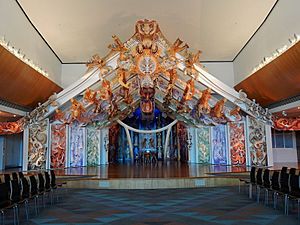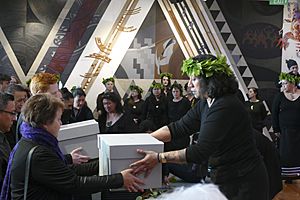Rongomaraeroa facts for kids

Rongomaraeroa is a special meeting place, called a marae, located inside the Museum of New Zealand Te Papa Tongarewa. It has a modern meeting house, known as a wharenui, called Te Hono ki Hawaiki. This unique marae is on the museum's 4th floor, looking out over Wellington harbour. It first opened its doors on November 30, 1997.
The design of Rongomaraeroa was led by Cliff Whiting, a famous carver and the first Māori leader of Te Papa. Its style is very modern and different from traditional marae. It is the only marae ever built specifically inside a museum. This shows how much Te Papa wants to celebrate both Māori and European cultures in New Zealand, a concept called biculturalism.
Contents
What is Rongomaraeroa Used For?

Rongomaraeroa is not just an exhibit; it's a "living marae." This means it's actively used for many events. For example, it hosts pōwhiri (welcoming ceremonies), special functions, and even tangi (funeral ceremonies).
In 2017 and 2018, important ceremonies took place here. These events were about returning Māori and Moriori ancestral remains, including toi moko (preserved tattooed heads), from museums in Europe and America. Rongomaraeroa is special because it's a national marae for all iwi (tribes) in New Zealand.
Traditional marae are always built on the ground. But Rongomaraeroa is on an upper floor of the museum. Because of this, Cliff Whiting playfully called it "the marae in the sky." This name also helped show that it belongs to the museum and has its own special rules, different from the local Te Āti Awa tribe's marae.
Even though some people first thought it was too modern, Rongomaraeroa is now seen as a true marae. It helps Te Papa connect different cultures. You can also rent Rongomaraeroa for private events.
It's important not to confuse Te Hono ki Hawaiki with another very old meeting house called Te Hau ki Tūranga. This older house is from the 1840s and is on display nearby in the Mana Whenua exhibition.
How Rongomaraeroa Was Designed
Rongomaraeroa has a large space of 350 square meters and can hold up to 250 people. The carvings for the wharenui were made by Cliff Whiting using a modern material called medium-density fibreboard (MDF). This was unusual because traditional carvings use rare native wood. Using MDF allowed for unique and detailed shapes.
The design also includes bright, non-traditional colours and ideas from European, Asian, and Polynesian art. This was done to represent all the different cultures in New Zealand today. Arapata Hakiwai, who followed Cliff Whiting, said in 2013 that the design "reflects the nation's bicultural foundations while embracing everyone." He added that Cliff "extended the boundaries of Māori art by using contemporary materials."
For example, the wharenui has a special three-part artwork that includes a Christian dove. This was designed so that both Māori and European visitors could connect with it.
Carvings and Stories
The carvings on the arches and pillars of Te Hono ki Hawaiki tell stories from Māori myths and legends. Some of these stories include:
- The tale of Māui slowing down the sun, shown on the maihi (the "arms" of the meeting house).
- The story of Hineahuone, the first woman, created by Tāne Mahuta, the god of the forest. This is shown in the doorway.
- Māui turning his brother-in-law, Irawaru, into a dog.
- The legend of Paikea, the whale rider.
- The changing relationship between Māori and Pākehā (European New Zealanders) is shown inside the cupboards of the poutokomanawa (the central post of the meeting house).
The design also made sure that guests could go straight to the marae for ceremonies without walking through other museum exhibits. This helps support the traditional pōwhiri process.
What the Names Mean
In Māori stories, Te Hono ki Hawaiki refers to Hawaiki. This is believed to be the original home island of all Polynesians.
Rongomaraeroa is another name for Rongo, who is the god of kūmara (sweet potato) and other farmed foods. Rongomaraeroa is also the name of marae belonging to some hapū (sub-tribes) of the Ngāti Kahungunu and Heretaunga Tamatea iwi on the South-Eastern coast of New Zealand's North Island.
Images for kids
See Also
- Māori mythology
- New Zealand design





